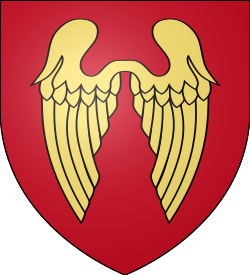Lord Edward Seymour (died 1593)
Lord Edward Seymour (c. 1528 - 2 May 1593), knight,[3] of Berry Pomeroy, Devon, was Sheriff of Devon in 1583 [4] and was knighted by his father the Duke of Somerset on the battlefield of Pinkie on 10 September 1547.

Origins
He was the eldest son (but not the main heir) of Edward Seymour, 1st Duke of Somerset (c.1500-1552) by his first wife Catherine Fillol (or Filliol) (c.1507-1535) a daughter and co-heiress of Sir William Fillol (1453-1527), of Fillol's Hall, Essex and Woodlands, Horton, Dorset.[5] The children from this first marriage ranked below those from the Duke's second marriage to Ann Stanhope, the eldest son of which, due apparently to his wife's persuasion, succeeded his father as Duke of Somerset. By an entail made during the time of his second marriage the Duke excluded from the inheritance of his estates the children of his first marriage. It has been alleged that adultery between Catherine Fillol and her father-in-law Sir John Seymour (d.1536) ended the Duke's first marriage.
Inheritance
In June 1553 he received the manor of Berry Pomeroy, Devon, including Berry Pomeroy Castle.
Marriage and children
He married Margaret Walshe, a daughter and co-heiress of John Walshe (c.1517-1572) (alias Walsh, Welsh, etc.) of Cathanger,[6] Fivehead, Somerset, Justice of the Common Pleas in 1563, MP for Cricklade (1547), Bristol (twice in 1553, twice in 1554, 1555, 1559, 1563), Somerset (1558)[7] by whom he had one son:
- Sir Edward Seymour, 1st Baronet (d.1613).
After the male line of the Seymour Dukes of Somerset in descent from the 1st Duke and his second wife Anne Stanhope failed on the death of Algernon Seymour, 7th Duke of Somerset (1684–1750), of Petworth House in Sussex (5th cousin of the 5th Baronet), the Berry Pomeroy family inherited the Dukedom in accordance with the special remainder, in the person of Sir Edward Seymour, 6th Baronet (1694–1757) of Berry Pomeroy, who in 1750 became the 8th Duke of Somerset. He inherited however none of the property of the 7th Duke, which went partly to his only daughter and her husband Sir Hugh Smithson, 4th Baronet (later created Duke of Northumberland) and partly to his nephew Sir Charles Wyndham, 4th Baronet (1710-1763), 2nd Earl of Egremont.
Monument in Berry Pomeroy
A monument to Lord Edward Seymour survives in St Mary's Church, Berry Pomeroy, standing against the north wall of the north aisle of the Seymour Chapel. It was described by the architectural historian Nikolaus Pevsner (1952) as: "The figure carving astonishingly naive. To think that the children of Lord Protector Somerset were satisfied with this!"[8] Hoskins (1959) on the contrary called it "fine".[9] The monument consists of three main effigies, each on its own step, the top two under a coffered arch two steps deep, each recumbent and propped up on the right elbow, gazing heavenwards, or perhaps towards the top of a now lost altar which once stood against the east wall of the chapel. Demonstrating perspective, the figures increase in size from the topmost step furthest from the viewer. The two male figures occupying the topmost two steps are bare-headed and dressed in full armour with breastplates. On the top step is Lord Edward Seymour, holding in his left hand the ceremonial baton of Sheriff of Devon (which is also visible on the monument to John Northcote (1570-1632) in Newton St Cyres Church). On the ground near his shoulder is his helmet. On the middle step is the effigy of Lord Edward's son, Sir Edward Seymour, 1st Baronet (died 1613), head propped up on his hand, with the latter's wife, Elizabeth Champernowne, occupying the lowest step. At the head end of Lady Elizabeth is a baby wrapped in swaddling clothes, and at her feet sitting in a chair is an infant child. At the apex of the arch, below the entablature is an escutcheon showing the arms of Seymour impaling Welshe, the wife of Lord Edward. On the very top of the monument, within a broken scroll pediment and above a putto's head, is an escutcheon showing the arms of Seymour alone, with mantling and with crest above. Above the topmost figure of Lord Edward is a black stone tablet, with the Seymour crest above, inscribed in gilt Roman capitals as follows:
"Here lyeth the bodies of the Honorable Lord Edward Seymour, knight, sonne unto the Right Honorable Edward Seymour, Duke of Somerset, who died the second daye of Maye, 1593; also of Edward Seymour his sonne, Baronet, who died the 10 daye of Aprell, 1613; the Lady Elizabeth his wife dawghter of Sir Arthwre Champernowne, who had isshew 11 childeren by him the sayed Edward Seymour, Baronet".
References
- Vivian, p.702, gives arms of Seymour of Berry Pomeroy as Gules, two wings conjoined in lure or
- Debrett's Peerage, 1968, p.1036, Duke of Somerset
- His name was officially Lord Edward Seymour, being not the designation of a baron but the courtesy title of the son of a duke. Per Vivian, Herald's Visitations of Devon, 1895, p.702, pedigree of Seymour of Berry Pomeroy, as confirmed by the inscription on his monument in Berry Pomeroy Church: Here lyeth the bodies of the Honorable Lord Edward Seymour, knight, sonne unto the Right Honorable Edward Seymour Duke of Somerset...
- The Complete Peerage vol.XIIpI, p.84.
- Vivian, Heraldic Visitations of Devon, 1895, p.702, pedigree of Seymour
- Vivian, p.702
- History of Parliament biography
- Pevsner, N., Buildings of England: Devon, Harmondsworth, 1952, p.49
- Hoskins, W.G., A New Survey of England: Devon, London, 1959, p.333